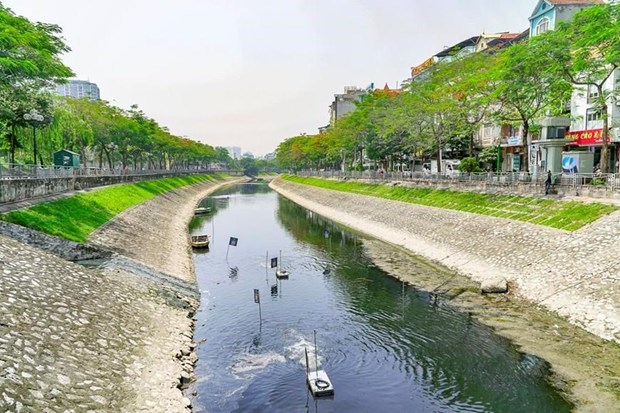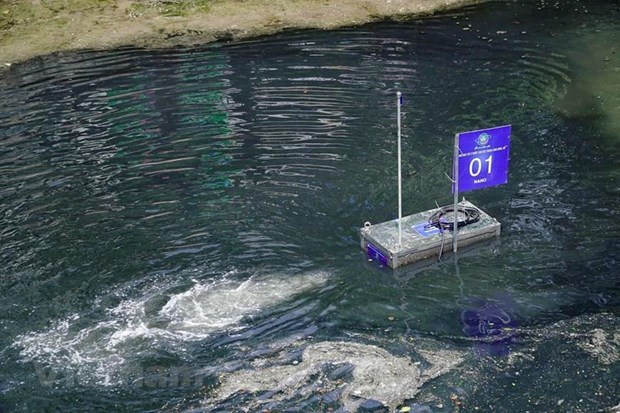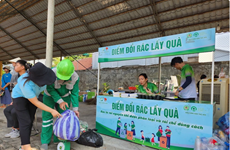Hanoians pin high hope on technology to purify polluted river
 A section of To Lich river passing Hoang Quoc Viet street, Cau Giay district (Photo: Vietnam+)
A section of To Lich river passing Hoang Quoc Viet street, Cau Giay district (Photo: Vietnam+)Many experts concluded that the Japanese solution has lived up to its advertisement in the first place. Specifically, the water’s colour and odour have been relatively improved after 5 days of applying the Nano - Bioreactor technology.
However, many insiders also hold that it is difficult to assess the solution’s effectiveness in the long run as there are now various sources of waste being emitted to the river.
Japanese technology expected to revive the so-called ‘dead river’
Having lived near the severely polluted river of To Lich, Nguyen Thi Hoa, a resident on Hoang Quoc Viet street expressed her delight when talking to Vietnamplus about the application of Nano-Bioreactor technology in treatment of the river’s water.
‘We have lived with a fear that the polluted river may entail a serious risk of diseases so we are always long for a project to clean it up. We hope this project will work,” Hoa said.
In response to local residents’ wishes for a cleaner To Lich river, Hanoi authorities launched the project to clean the section of the capital’s infamously polluted To Lich River on May 16.
The Japanese cleaning equipment was used on the most polluted section of the river located near Hoang Quoc Viet Street in Cau Giay District.
Called the Nano Bioreactor, the equipment was placed on the bed of a 300-metre section of the river.
Dr Tadashi Yamamura, UN environment expert and President of the Japan Environment and Trade Promotion Organisation, who has brought up the project in a meeting with Prime Minister Nguyen Xuan Phuc and worked with Hanoi's authorities to obtain permission to pilot the project, said the nano-bioreactor has proved its worth in similar cases in Japan, China and the US and believed their technology could be of use here after two years of surveying.
“In Vietnam, one of the biggest problems with the To Lich River is the thick sludge at its bed that is the source of the smell, and this could be solved by the nano bioreactor,” he said.
 A Japanese water filter operating in To Lịch river (Photo: Vietnam+)
A Japanese water filter operating in To Lịch river (Photo: Vietnam+)The technology involves two main components – nano air blowers and nano-bioreactor panels made from porous volcanic rocks in Japan.
According to Tadashi Yamamura, the bioreactor panels serve to “activate” the micro-organisms in the water, encouraging them to break down H2O particles to release oxygen.
With the increased level of oxygen in the water, fish and other water creatures can thrive.
The air blowers, pumping nano air bubbles into the mud, are meant to prevent mud settling down on the riverbed.
The system, which is also being piloted at a corner of the city's West Lake, could be seen as “a wastewater treatment facility” on the riverbed, the Japanese expert said.
Time needed to assess the project’s effectiveness
However, not everyone is convinced and some have voiced concerns about the long-term viability over the project, especially over the possibility that the river might need constant pumping of air to avoid pollution.
Dao Trong Tu, director of Vietnam River Network, an organisation which aims to protect rivers in the country, said the Japanese technology is not anything novel and many methods have been tested on polluted lakes and rivers across the country, including the To Lich River, but the results failed to live up to the high expectations.
“If the technology’s endgame is to improve the smell or the colour of the river’s water, then it is nothing new. Everyone knows how a pond or a lake’s water can be cleared up significantly if treated with alum,” Tu said.
He also noted how it would be more complicated as the To Lich is no longer a true river, given that the freshwater supply that goes into the lake is dwarfed by other sources, namely wastewater and rainwater.
Tu remarked that if the issue of wastewater discharges into the river is not dealt with, any solution would just be temporary.
In the short-term, Hanoians might no longer have to turn up their nose at the rancid smell, especially during the hot summer, but testing is needed before declaring the project successful, he added.
 A group of workers performs regular examination on the water filter system (Photo: Vietnam+)
A group of workers performs regular examination on the water filter system (Photo: Vietnam+)Pham Van Cuong, former director of Hanoi’s water discharge project management unit, said the city is building the 4,800ha Yen Xa wastewater treatment factory with daily capacity of 270,000cu.m.
Once operational, the facility would collect and handle all wastewater discharged from households alongside the To Lich River, which means the river would no longer have to bear the polluted water, Cuong said.
City authorities are also considering pumping water from West Lake to flush out the pollution from the To Lich River.
Previously, Le Cong Thanh, deputy minister of environment and natural resources, said the Japanese technology being piloted at To Lich River is merely a test and the results remain to be seen.
“The ministry has assigned relevant units to constantly monitor the water’s quality and assess the efficiency as well as the practicality of the technology,” Thanh said.
According to the environment ministry, the pilot project will go on for two months with expenses borne by the Japanese side./.











